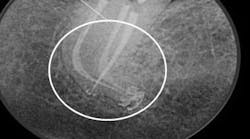ALSO BY DR. DIWAKAR KINRA | Comfortably numb: how dental anesthesia can differentiate your endodontic practice
There are many different obturation techniques; no one technique has been identified as clearly superior. It has been shown that adding heat to obturation increases success rates and allows for obturation of canal irregularities and anatomy that traditional techniques may not seal. (3)
ALSO BY DR. DIWAKAR KINRA |Are we clean yet? A look at endodontic instrumentation
The importance of three-dimensional obturation of the root canal system cannot be overemphasized. However, the ability to achieve this goal is primarily dependent on the quality of the canal cleaning and shaping, as well as the skill of the clinician. Even with the most skilled clinician, however, many other factors enter into the eventual success or failure of each case. These include the materials used, how the clinician uses those specific materials, and the radiographic interpretation of the case.
What may be considered the most important factor is the coronal restoration of the tooth following canal obturation. There is reasonable evidence to suggest that coronal leakage through improperly placed restorations after root canal treatment and failure of the restorative treatment or lack of health of the supporting periodontium are the final determinants of success or failure in treatment. (4,5,6)
Characteristics of well-done obturation are defined and categorized as the three-dimensional filling of the entire root canal system as close to the cemento-dentinal junction as possible; i.e., without gross overextension or underfilling in the presence of a patent canal. Minimal amounts of root canal sealers — most of which have been shown to be biocompatible or tolerated by the tissues in their set state — are used in conjunction with the core filling material to establish an adequate seal. However, it is only through a knowledgeable approach to root canal treatment that quality assurance can be continually demonstrated in the obturation of the canal system. (7)
Controversy has surrounded root canal obturation for many years. Clinicians and academics alike have researched, studied, applied, and compared many warm obturation techniques, and no single technique has been proven superior to another, leaving clinicians to experiment and form preferences through trial.
In this must-watch video, Dr. Manor Haas does an excellent job reviewing the misconceptions associated among warm obturation techniques. This is by no means an endorsement for any particular brand or method, but a great video interpretation of the current controversies in endodontic obturation.
References
1. Simons J, Ibanez B, Friedman S, Trope M. Leakage after lateral condensation with finger spreaders and D-11-T spreaders. J Endod 1991;17:101-104.
2. Seltzer S, Green DB, Weiner N, DeRenzis F. A scanning electron microscope examination of silver cones removed from endodontically treated teeth. J Endod 2004;30:463-474.
3. Collins, J, Walker, M, Kulild J. A comparison of three gutta-percha obturation techniques to replicate canal irregularities. J Endod 2006;32:762-765.
4. Saunders WP, Saunders EM. Coronal leakage as a cause of failure in root canal therapy: a review. Endod Dent Traumatol 1994;10:105.
5. Vire DE. Failure of endodontically treated teeth. J Endod 1991;17:338.
6. Ray HA, Trope M. Periapical status of endodontically treated teeth in relation to the technical quality of the root filling and the coronal restoration. Int Endod J 1995;28:12-18.
7. Gutmann JL, Dumsha TC, Lovdahl PE. Problem solving in endodontics, 4th edition, St Louis, 2006; Mosby-Elsevier, Chapter 1.







